- How to improve the keeping quality of root crops.
- Why do deformed carrots grow?
- When to dig up carrots.
- Harvesting carrots.
- Preparing the harvest for storage.
- How to save dug carrots
Carrots are the most common vegetable found in Russian gardens. When grown, it is quite unpretentious, but in order to grow and preserve root crops you need to know some nuances.
Agricultural practices that improve the quality and keeping quality of carrots
Carrots need very loose soil without lumps and pebbles. Therefore, they dig deep to 20-25 cm and carefully break up all the lumps. In dense soil, carrots grow small. The crop grows well on loose, rich soil with a sufficient admixture of sand. The soil must be neutral or slightly acidic (pH 5-6.5). If the acidity is high, the soil should be limed a year before planting carrots, or, in extreme cases, in the fall.
When planting and growing, you should not apply a large amount of fertilizer; the vegetable becomes woody and loses its taste. You can’t even add half-rotted manure; it will cause the carrots to rot right in the ground.
Before sowing, it is advisable to keep the seeds for half an hour in running water or soak them for 2-4 hours. When soaking, the essential oils that prevent germination are washed out of the seeds. Reception allows you to get friendly and quick shoots. Sow carrots as early as possible at a temperature of at least 4°C. Pre-winter sowing of root crops is possible. In the northern regions and the middle zone, late sowing of the crop is acceptable (the first ten days of June), if at this time the temperature does not exceed 18-20°C.
After sowing, in hot weather, the bed is watered with a watering can with a divider, but not very much, otherwise the seeds will go deep. The crop needs sufficient watering during the first period of growth. Then she gets enough precipitation. And only if the summer is dry, the beds with plants are watered once a week.
The beds should not be allowed to become overgrown with weeds during the germination period and in the first half of the growing season until the tops cover the row spacing.
Weeds emerge before the crop and make it difficult to germinate. And it’s very difficult to see rows of crops in a continuous green carpet.Therefore, the rows are covered with peat so that they are clearly visible, and the rows are weeded without fear of damaging the seedlings. Without weeding during this period, the root crops become smaller.
When the plants have 2 leaves, they are thinned out, leaving a distance of 10 cm between them. You can leave 5-7 cm, and then gradually pull them apart, using young, growing root crops for food.
Carrots are a potassium lover, so they are given one potassium supplement per season. Potassium fertilizer should not contain chlorine, since the crop does not tolerate it.
Root deformations
Multi-tailed specimens are often found. Carrots form a branched root crop in the following cases.
- When transplanting. The culture does not tolerate transplantation. Transplanted root crops always branch. Their growth point is at the end of the root, and when transplanted, the root bends or breaks off, the growth point is injured, and the root can no longer grow in length. Dormant buds awaken on it, each of which produces a new root.
- During the process of growth, the root encounters a pebble or lump of earth that it cannot overcome. Then the central axis stops growing and bifurcates. The soil for the crop should be loose to a depth of 30-40 cm.
- Excessive doses of nitrogen. Fertilizers should not be applied in any form, and even during planting, nitrogen should not be applied. Neither compost nor humus is added under the carrots. Do not water with grass fertilizer under any circumstances. If there is too much nitrogen in the soil, then the vegetable not only branches, but also cracks, and quickly rots during storage. For the same reason, carrots should not be planted after legumes.
- Adding lime during planting also causes root branching. Ash should not be added during planting.
In addition to branching, other deformations occur.If the main root passes through dense layers of soil during the growth process, then constrictions form on it.
If there is excess moisture in the soil in the last 35-45 days of growth, the roots crack. Therefore, 1-1.5 months before harvesting carrots, watering is stopped.
When to dig carrots from the beds
The timing of carrot harvesting depends on the variety and sowing time of the crop.
- Early varieties of carrots can be dug up after 80-90 days (Amsterdamskaya, Parisskaya Karotel varieties).
- Mid-season varieties are ready for harvesting in 100-120 days. These include the Nantes and Shantane varieties.
- Late varieties are dug up after 120-160 days (varieties Berlicum, Valeria (another name for Flakke)).
The main sign of ripening of root crops is the appearance of white hairs on them - these are sucking roots. If the crop is not dug up at this time, the roots will grow, the root crop itself will become woody and sprout.
Any variety must remain in the ground for at least 80 days, then the vegetable will become an acceptable size for harvesting and some sugars will accumulate in it.
Late carrots, if they are not overgrown with hairs, can be dug after frost, since the crop is not afraid of cold weather. In the ground, root crops can withstand temperatures down to -5°C without freezing. After freezing, the bitter substances in them are destroyed and the carrots become sugary.
If there are no white hairs on the carrots, you cannot dig them up. The harvest is not yet ripe, sugars and amino acids have not accumulated in the roots, metabolic processes are very intense. When digging carrots ahead of time, the root crops are not stored, quickly rot or become dry, flabby and tasteless. Early harvesting is permissible only if the crop is processed immediately.
Harvesting carrots
Dig carrots on a dry, cloudy, cool day.Since the root crops are long (15-20 cm), there is no need to pull them out of the ground by the tops; they often break. To dig carrots, the soil is lightly raked from its tops, then dug with a shovel, lifting the carrots and removing them from the ground. Long root vegetables are dug up to the fullest extent, otherwise they will break off.
Do not dig up carrots with a pitchfork, since it is easy to pierce the root vegetables, then they will not be stored. Root cuts heal quickly, but punctures do not heal for a long time. When digging, an infection often gets into the puncture and the root crop rots. During storage, the tissue around the puncture becomes woody and rough, the vegetable itself loses a significant amount of sugars and becomes tasteless.
Short-fruited varieties (for example, Karotel) are pulled out by the tops; their root crops are short, round and do not break during harvesting. However, in the case of very dense soil, even these varieties have to be dug up.
The dug carrots are placed along the edge of the bed, and after harvesting is completed, they immediately begin to process the crop.
Preparing the harvest for storage
Preparation of the crop for storage is carried out within 1-2 days. When the process is delayed, root vegetables lose a large amount of moisture, become flabby, the process of destruction of sugars occurs and the vegetables become tasteless. Preparation for storage consists of:
- removal of tops;
- washing root vegetables;
- top trimmings;
- crop sorting;
- drying.
Removing tops. Immediately after digging up the carrots, all tops are removed. The leaves evaporate water very strongly, and if they are not trimmed in time, the root crops wither. The tops can be twisted or cut with a knife
Washing. After removing the tops, the root vegetables are washed. You can add potassium permanganate to a container of water until it turns slightly pink.The solution disinfects vegetables, and they are stored much better. You don’t have to wash the crop, it doesn’t affect the keeping quality in any way. Washing is more of an aesthetic characteristic: washed carrots are more pleasant to pick up than dirty ones with lumps of earth.
Trimming the top. During the washing process, the green top, where the growing point is located, is removed from the carrots. The shelf life of such vegetables increases, they evaporate less moisture and do not germinate during storage. It is necessary to trim the top when washing; if it is removed along with the tops, then an infection can occur.
Sorting. When washing, carrots are immediately sorted. Root crops that are cracked, diseased, or damaged during harvesting are discarded. Such specimens are not stored because they are a source of infection for the entire crop.
Ugly root vegetables are stored separately. Despite its unattractive appearance, multi-tailed carrots lie no worse than normal specimens.
The rest of the harvest is sorted according to the size of the roots into large, medium and small. Small carrots are usually loose and wither faster, so they are stored separately.
Drying the crop. Washed root vegetables are dried for 3-4 hours outside or 6-7 hours under a canopy. Vegetables are laid out in one layer and turned regularly. On a sunny day, the harvest is dried under a canopy. Then they are put in a dark and cool place, preferably the temperature does not exceed 8-10°C for 7-10 days. During this time, the carrots form a skin, the wounds heal and all specimens unsuitable for storage are identified. After drying, the vegetables are re-inspected and stored.
Basic rules for storing carrots in winter
Carrots are more difficult to preserve than beets. Early varieties are not stored under any conditions. They are grown for sale, for canning, consumption and processing in the summer.Middle and late varieties are stored until spring under proper conditions. The main thing is to reduce the evaporation of moisture from the surface of vegetables. Short root vegetables spoil the fastest. The longer and wider the vegetable, the more stable it is.
The dormant period of carrots is shorter and deeper than that of beets; they breathe more intensely and germinate earlier. To increase shelf life, it is necessary to strictly adhere to the storage requirements of this root crop.
- Air temperature +1-3°C.
- Humidity 85-95%.
- Constant flow of fresh air.
- Darkness. In the light, the sugars contained in the vegetable are quickly destroyed.
Temperature and humidity during storage should not fluctuate greatly.
You can store carrots in winter where these conditions are met. It’s easiest for residents of private houses; there is always room for harvest there. In apartments, the harvest is stored on the balcony, in the refrigerator, pantry, basement or in non-residential buildings: sheds, garages.

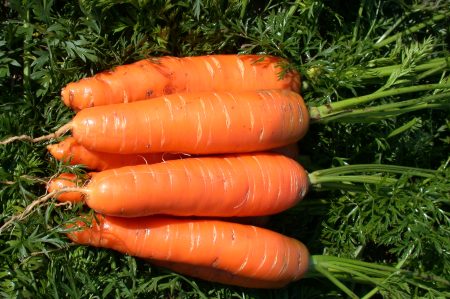
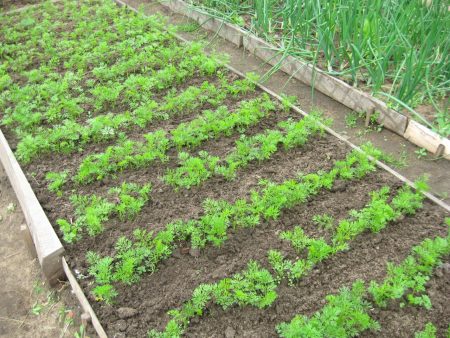

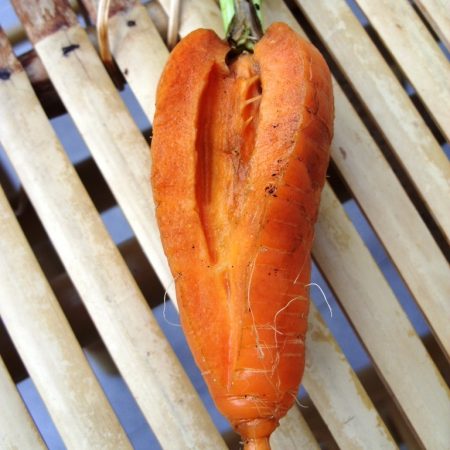
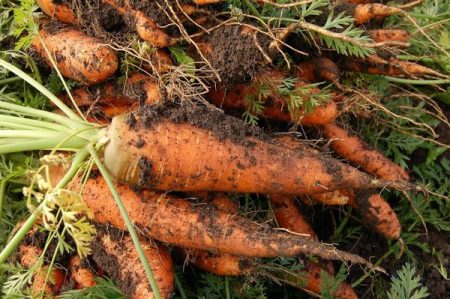
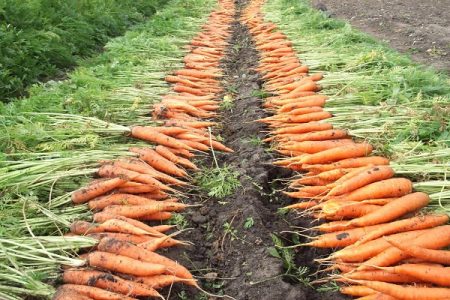
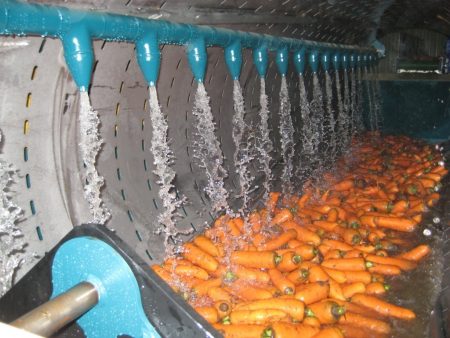

 (7 ratings, average: 4,71 out of 5)
(7 ratings, average: 4,71 out of 5) CUCUMBERS NEVER GET SICK, I'VE BEEN USING ONLY THIS FOR 40 YEARS! I SHARE A SECRET WITH YOU, CUCUMBERS ARE LIKE THE PICTURE!
CUCUMBERS NEVER GET SICK, I'VE BEEN USING ONLY THIS FOR 40 YEARS! I SHARE A SECRET WITH YOU, CUCUMBERS ARE LIKE THE PICTURE! You can dig a bucket of potatoes from each bush. Do you think these are fairy tales? Watch the video
You can dig a bucket of potatoes from each bush. Do you think these are fairy tales? Watch the video
 How our fellow gardeners work in Korea. There is a lot to learn and just fun to watch.
How our fellow gardeners work in Korea. There is a lot to learn and just fun to watch. Eye trainer. The author claims that with daily viewing, vision is restored. They don't charge money for views.
Eye trainer. The author claims that with daily viewing, vision is restored. They don't charge money for views. A 3-ingredient cake recipe in 30 minutes is better than Napoleon. Simple and very tasty.
A 3-ingredient cake recipe in 30 minutes is better than Napoleon. Simple and very tasty. Therapeutic exercises for cervical osteochondrosis. A complete set of exercises.
Therapeutic exercises for cervical osteochondrosis. A complete set of exercises. Which indoor plants match your zodiac sign?
Which indoor plants match your zodiac sign? What about them? Excursion to German dachas.
What about them? Excursion to German dachas.